Key Insights
- During Q4, daily active accounts and new accounts increased by 64% and 49%, respectively. The spike is likely due to users moving away from FTX, the launch of USDT, and the launch of nomination pools.
- Since launching in May, XCM has transmitted over 166,000 transfers across 70 channels. The expansion of XCM is critical to the continued advancement of the Polkadot ecosystem. The next iteration of XCM, XCM V3, will introduce seamless crypto-asset transfers, enhanced cross-chain interoperability, NFT support, and bridging to external networks.
- One year after the first parachain slot auctions, 35 slots have been won, resulting in a total of 133 million DOT (10.5% of the total supply) being bonded. Regular parachain auctions are due to continue throughout 2023 on a bi-weekly basis.
- The Web3 Foundation went on record to state Polkadot’s native token DOT has morphed and was no longer a security. The Foundation has ensured the vision of token morphing set out by the U.S. Securities and Exchange Commission has been addressed and has taken steps to ensure Polkadot provides safety to token holders, and that its token is compliant with the law.
- The next iteration of Polkadot Governance, OpenGov, is live on Kusama and is expected to go live on Polkadot in the near future. OpenGov allows every decision in the network to be made as a result of referenda tabled by the community, and for the first time, multiple referenda can run concurrently, allowing for the faster passage of motions.
Primer on Polkadot
Polkadot is a Nominated Proof-of-Stake (NPoS) blockchain network designed to support various interconnected, application-specific Layer-1 chains known as parachains. Each chain built within Polkadot uses Parity Technologies’ blockchain development framework Substrate, which allows developers to select specific components that best suit their application-specific chain. Polkadot refers to the entire ecosystem of parachains that plug into a single base platform known as the Relay Chain. This base platform does not support application functionality but instead houses all validators and is responsible for securing, governing, and connecting the parachains.
Key Metrics
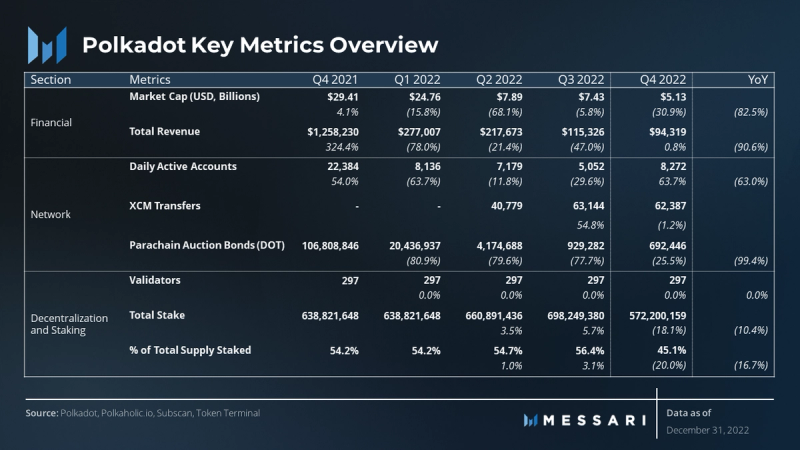
Note: The key metrics refer only to the Polkadot Relay Chain and not parachains.
Performance Analysis
Financial and Network Overview
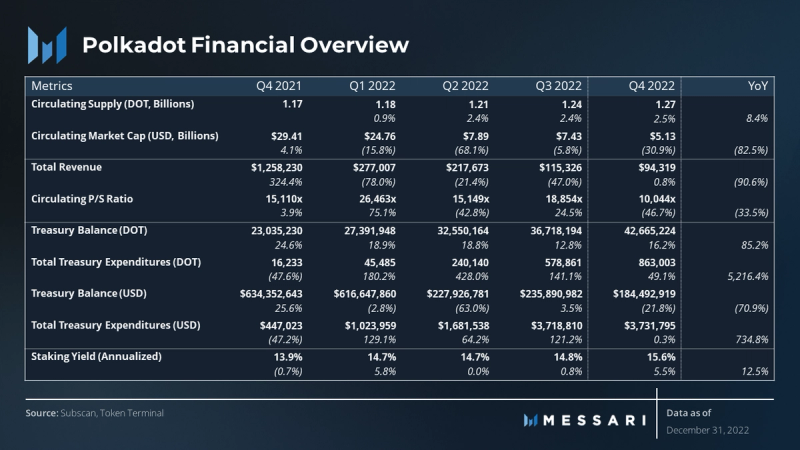
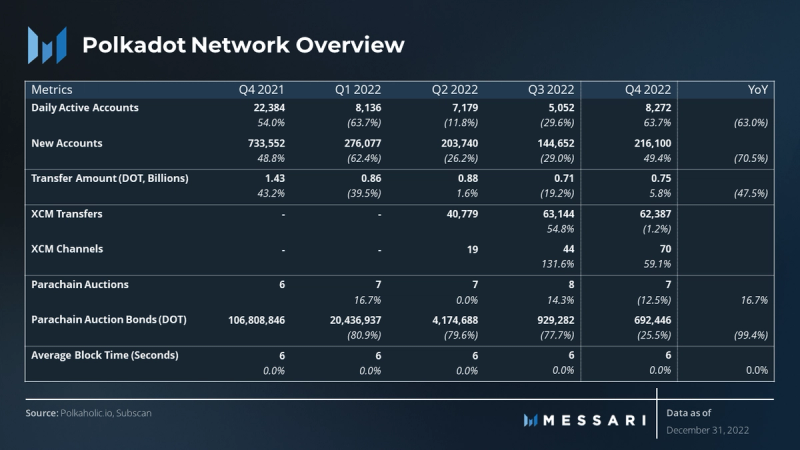
Note: Unless otherwise stated, performance metrics refer only to the Polkadot Relay Chain and not parachains.
The FTX scandal was the most significant event in Q4 2022, causing shockwaves and gaining worldwide attention. As expected, the Polkadot market cap suffered, dropping 31% quarter-over-quarter (QoQ). With the effects of FTX and the overall bear market, Polkadot’s market cap is down 83% year-over-year (YoY).
Despite the decline in value, network financials were stable. During Q4, quarterly revenue remained flat, and the supply of DOT tokens increased as expected. In November, the Web3 Foundation reported that after three years of discussions with the Securities and Exchange Commission (SEC), the DOT token, initially offered as a security, was no longer deemed a security.
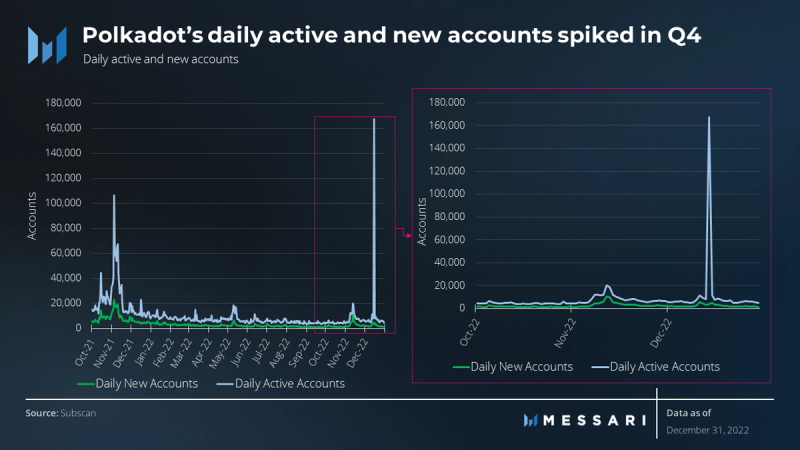
Additionally, the Polkadot Relay Chain showed impressive QoQ growth in Q4 2022, arguably its strongest quarter of the year. Daily active accounts rose 64% and new accounts increased 49%. The spike is likely due to users moving away from FTX and seeking more open, transparent, and decentralized networks like Polkadot, the launch of USDT, and the launch of nomination pools.
It’s crucial to note that the aforementioned metrics refer only to the Polkadot Relay Chain and not parachains. Although most activity in the Polkadot ecosystem occurs on parachains, it’s currently challenging to compile complete parachain data. Hence, the aforementioned metrics don’t encompass the entire ecosystem. A more accurate metric for measuring ecosystem performance today is XCM activity.
Cross-Consensus Message Format (XCM)

The Cross-Consensus Message Format (XCM) is a language that facilitates communication between parachains by enabling them to send messages. XCM messages can be transmitted via HRMP channels between parachains, from parachains to the Relay Chain, and even beyond the Polkadot ecosystem to other applications and base layers. XCM is versatile, serving various purposes such as operations, asset transfers, and teleportation.
Following the passage of Referendum 60, XCM went live on the Polkadot mainnet in early May. Since launching, XCM has transmitted over 166,000 transfers across 70 channels. The most popular channels involve the Relay Chain with popular parachains Acala, Astar, Parallel, and Moonbeam.
The expansion of XCM is critical to the continued advancement of the Polkadot ecosystem. The next iteration of XCM, XCM V3, is expected to be launched in the near future. It will introduce new features including enhanced programmability, bridging to external networks, cross-chain locking, improved fee payments, NFTs, and more.
Parachain Slot Auctions
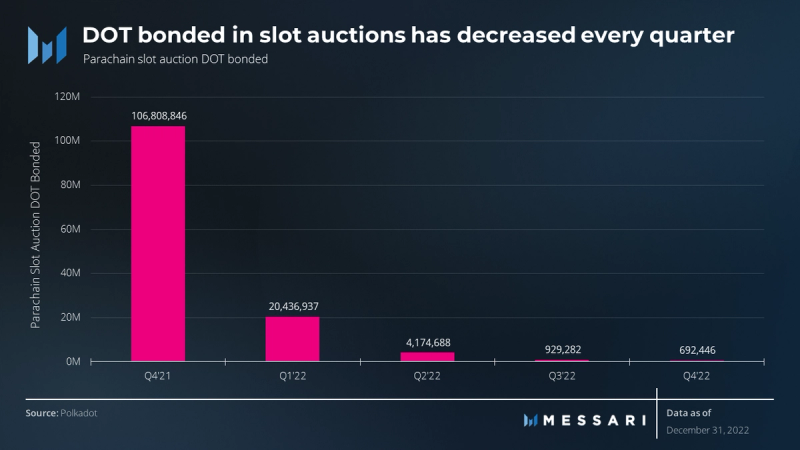
The first auctions for parachain slots began in the fourth quarter of 2021. As expected, the initial auctions attracted a large number of participants. They resulted in high amounts of DOT being bonded, due to the high level of anticipation leading up to the launch and the bull market conditions. Since the initial auctions, the amount of DOT bonded has decreased in every consecutive quarter.
As the requirements to win a slot have decreased, more projects have been able to self-fund their slot acquisitions. In other words, they did not need to raise DOT from the community in exchange for their own tokens. Consequently, these projects were able to retain a larger proportion of their native tokens, which they could then sell through other means, distribute to the community, or keep in reserve.
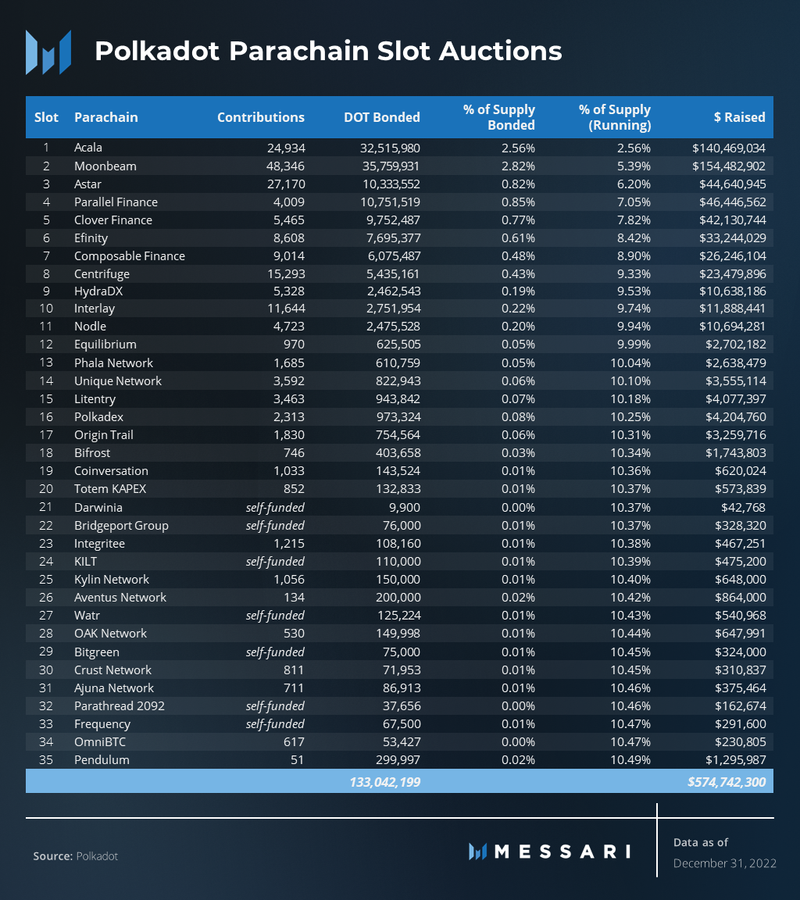
In the year following the first parachain slot auctions, 35 slots were won, resulting in a total of 133 million DOT (10.5% of the total supply) being bonded. As of now, slot auctions are planned through February 2023, which would bring the total to 41, but regular parachain auctions are due to continue throughout 2023 on a bi-weekly basis. It is believed that the Polkadot network has the capacity to support a maximum of 100 parachains, and in the future additional Relay Chains could be added thus increasing the number of supported parachains.
It’s also important to note that the leases for parachain slots are 96 weeks long. Therefore, the first round of parachains is approaching the halfway point of their leases. Once their leases expire, a significant portion of the DOT bonded will become liquid. This situation is similar to the upcoming Shanghai upgrade for Ethereum, which could serve as a point of reference. It will also be intriguing to observe whether well-established projects choose to seek a second round of community contributions or self-fund their re-leasing of the slot.
During Q4, seven new teams won parachain slots:
- Bitgreen – Bitgreen allows organizations and individuals to invest in sustainability markets, purchase high-quality tokenized carbon credits, and participate in sustainable finance. Bitgreen is a climate-positive blockchain that conserves critical rainforests, finances clean infrastructure, and protects vulnerable communities.
- Crust Network – Crust Network is a decentralized cloud storage provider that supports multiple storage-layer protocols like IPFS and exposes instant accessible on-chain storage functions to users. Crust’s technical stack is also capable of supporting data manipulating and computing.
- Ajuna Network – The Ajuna platform provides a simplified way for Unreal and Unity developers to build an incentive layer into their games using tokenized virtual goods. The partnership with Integritee will allow Ajuna to run entire gaming engines in trusted execution environments to create fast, secure, and scalable decentralized gaming ecosystems. The ultimate goal of Ajuna is to develop an interoperable, decentralized gaming ecosystem where virtual goods can be exchanged.
- Parathread 2092 – This is a project that is well known within the Polkadot community but has chosen to remain anonymous for the time being until reaching its next milestone.
- Frequency – Frequency enables Web3 social at scale by allowing applications to collaborate instead of compete when submitting transactions. Frequency has four core features for developers: capacity economics to scale without fear of being priced out, coinless users and delegation to grow a user base without friction, off-chain data broadcasting to maximize throughput with transparency, and shared schemas to standardize data interoperability.
- OmniBTC – OmniBTC is a decentralized omnichain liquidity aggregation protocol (DOLA) with single coin pools of each public chain as the core, cross-chain interoperability protocols such as Wormhole, LayerZero as the bridge, and Sui public chain as the settlement center. Each public chain’s single coin pool allows users on any chain to provide liquidity to the protocol. The cross-chain messaging protocol is responsible for interconnecting the single coin pools, and the Sui public chain acts as the clearing house, bringing security, concurrency, and low fees to the protocol.
- Pendulum – Pendulum aims to establish the missing link between the fiat and DeFi ecosystems through a fiat-optimized smart contract blockchain. Pendulum will allow connecting DeFi applications to foreign exchange markets, building AMMs to introduce scalable liquidity pools for fiat currencies, and creating yield-earning opportunities for fiat token holders.
Active Parachain News
- Kilt achieved a significant milestone by becoming the first parachain to successfully migrate from Kusama to Polkadot. KILT, which provides self-sovereign and verifiable blockchain identity solutions, made this move due to the need for higher stability and security as large enterprises started adopting their technology. Kusama was a valuable testing ground for KILT, allowing for rapid application development and experimentation, but the KILT team required a more secure environment for their enterprise clients. The stability and security offered by Polkadot will enable KILT to further its Web3 journey, as Kusama provided valuable insights along the way.
- Astar Network and NTT Docomo, Japan’s leading mobile carrier, have teamed up to drive widespread adoption of Web3 and its social applications. NTT Docomo will invest up to $4 billion in decentralized technology and the two companies will collaborate to achieve sustainable development goals, promote Web3 adoption through education, and cultivate Web talent. The Japan Blockchain Association named Astar as the recipient of the Product of the Year award, with its founder and CEO, Sota Watanabe, winning Person of the Year for the second consecutive year.
A review of parachain events from December can be found here, and a recap of leading parachains from 2022 can be found here.
Treasury
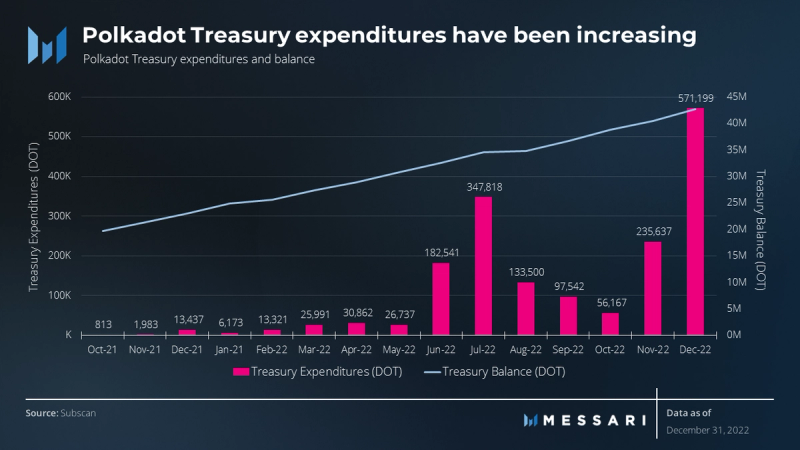
The Polkadot Treasury is funded by block rewards, validator slashing, transaction fees, and staking inefficiencies. In the future, parathreads will also generate treasury funds by participating in per-block auctions for block inclusion.
By the end of Q4, the Treasury held 43 million DOT ($184 million), marking a YoY increase of 85%. The Treasury experienced its highest monthly expenses during this quarter, with a total of 863,000 DOT spent. The majority of these expenditures, 571,000 DOT, were made through the Ethereum-to-Polkadot Snowbridge in December, making it the largest treasury expense of the year.
During 2022, the Treasury disbursed 1.8 million DOT ($8 million). The implementation of the new OpenGov model in 2023 will likely result in an increase in Treasury usage, as outlined later in the report.
Developer Activity
Polkadot has been one of the most active platforms in terms of developer activity, which is often a key indicator of future development, adoption, and overall success. Polkadot reached an all-time high in development activity, as measured by GitHub commitments, in Q3. This growth was also highlighted in the annual Electric Capital Developer report, which showed that Polkadot has grown from less than 200 developers in 2018 to over 2,000 today, ranking it as the second largest full-time developer community with 764 full-time developers. It is also the fastest ecosystem to reach 200 full-time developers, making it in 2.2 years compared to the average of over 4 years. However, Polkadot’s total developers only grew by 2% in 2022, indicating a slowing rate of growth.
Additionally, the Web3 Foundation and edX, a leading online learning platform, jointly launched foundational development courses for Polkadot to support its developer community. On November 28-29, the annual Sub0 developer conference took place.
In October, it was announced that Gavin Wood, founder of Polkadot and prominent figure in the industry, was stepping down as CEO of Parity. Despite this change, he remains the majority shareholder of the company and now holds the position of Chief Architect, where he can concentrate more fully on development efforts.
Polkadot offers a comprehensive Web3 ecosystem, offering various methods to construct and integrate Web3 solutions at every level of the blockchain stack. The Polkadot ecosystem encompasses projects that focus on each layer of the stack, including the underlying infrastructure and the Relay Chain, as well as other areas such as runtime pallets, parachains, Layer-2s, developer tools, wallets, block explorers, APIs, oracles, and more. The complete open-source technology stack for Polkadot can be found here.
Decentralization and Staking
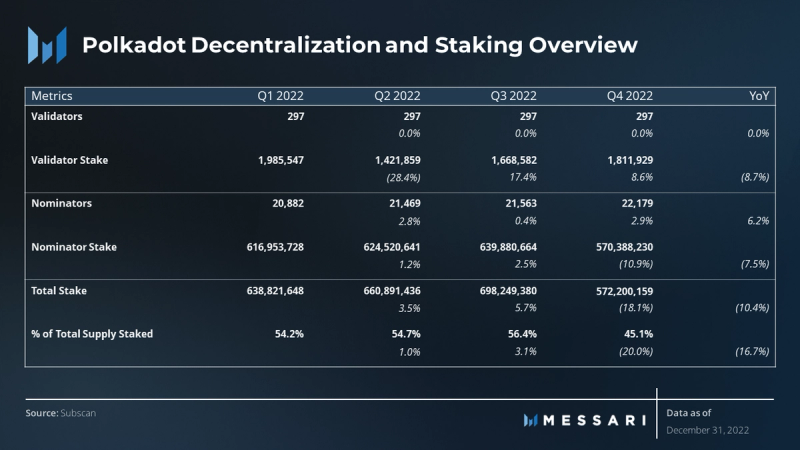
Polkadot uses Nominated Proof-of-Stake (NPoS) consensus. Unlike Delegated Proof-of-Stake (DPoS), NPoS subjects nominators to slashing. Previously, there was a minimum DOT requirement to receive rewards through nomination, but this changed with the introduction of nomination pools in Q4.
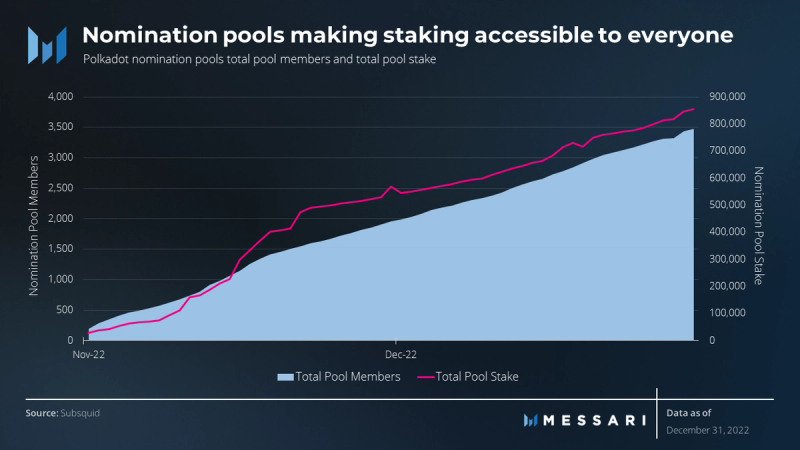
Nomination pools are a new feature for the Polkadot staking system. They allow multiple DOT holders to pool their tokens together and act as a single nominator, supporting a chosen set of validators with their combined stake. Rewards are divided pro-rata among pool members, and no commission is taken. Hosted on-chain and as part of the Polkadot runtime, these pools are upgradeable, secure, and fully integrated into the Relay Chain. Nomination pools make staking accessible to everyone with as little as one DOT, and are supported by the staking dashboard as well as popular wallets Nova Wallet, Talisman, and SubWallet.
Since the launch of nomination pools in late Q3, the number of nomination pool members has steadily increased. As of the end of Q4, there were a total of 3,500 members with a combined stake of 850,000 DOT.
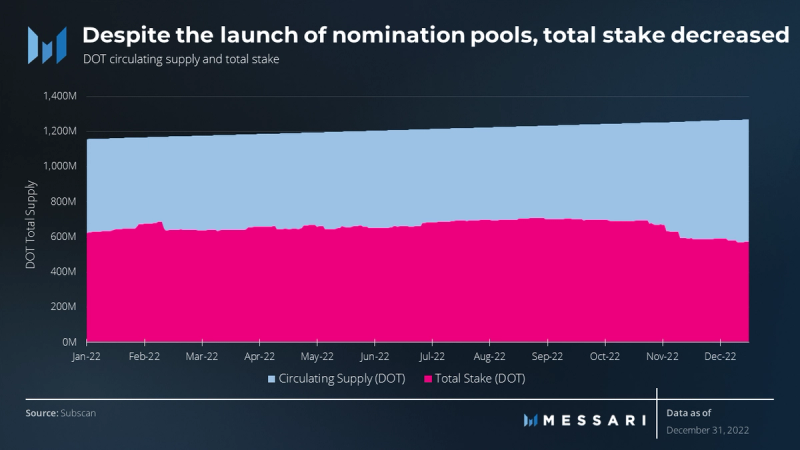
Interestingly, despite the launch of nomination pools, Polkadot’s staking metrics saw a decline in Q4. Total stake dropped 18% quarter-over-quarter, from 698 million to 572 million, causing the percentage of circulating supply staked to decrease from 56% to 45%.
Qualitative Analysis
Governance
OpenGov
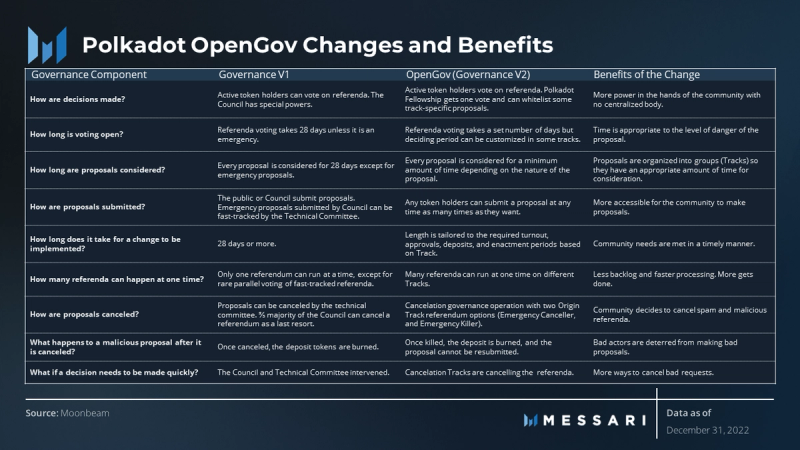
In June, Gavin Wood announced OpenGov (formerly known as Governance V2) as the next iteration of Polkadot’s governance system during Polkadot Decoded. OpenGov is a significant upgrade that marks the beginning of a new era for Polkadot. In OpenGov, the community will play a central role in guiding the direction of the project, as opposed to Parity and Web3 leading the way as in the past.
OpenGov allows every decision in the network to be made as a result of referenda tabled by the community. For the first time, multiple referenda can run concurrently, allowing for the faster passage of motions. Proposals are grouped into different tiers, with each tier having specific conditions such as a designated voting period, the number of eligible votes at one time (e.g., only two votes in tier two), and a required deposit in DOT. The conditions for passing a proposal become more stringent as the tiers increase.
OpenGov replaces the Council and Technical Committee with a new entity called the Fellowship. The Fellowship serves three main functions within Polkadot’s governance and community:
- Acting as a technical advisor for the governance system.
- Maintaining and developing core protocols and code.
- Educating and promoting the technology of Polkadot.
The Fellowship operates like a developer DAO, where all users are eligible to join, thus reducing concerns of centralization. It has a ranking system with multiple mechanisms that ensure decentralization. These include a constitution, community voting for senior positions, and checks and balances to limit the control of leadership. The Fellowship cannot pass referenda, but it can whitelist them, which makes them easier and quicker to pass.
To facilitate the seamless implementation of OpenGov, the Collectives parachain was launched on the Polkadot network. The Collectives chain hosts on-chain collectives that serve the Polkadot ecosystem. These collectives provide a home for the Fellowship, as well as the Polkadot Alliance, an on-chain organization that aims to promote fair use of the Polkadot brand and open-source code.
In November, OpenGov was launched on Kusama, and in December, for the first time, two governance bodies voted simultaneously and in coordination to approve an on-chain proposal, including the Fellowship. The vote served as a real-world demonstration of the system’s capabilities, showing users what they can expect from the Polkadot network in the near future.
Q4 2022 Governance and Network Upgrades
Polkadot combines a multi-pronged governance system with autonomous enactment to upgrade the network without hard forks.
During Q4 2022, Polkadot users enacted 13 referenda:
- Referendum 74 – Second batch of Statemint HRMP channels
- Referendum 77 – Gossamer ongoing development grant
- Referendum 78 – Nomination pools initial configuration
- Referendum 79 – Runtime Upgrade v9291 on Polkadot + v9290 on Statemint
- Referendum 80 – USDT token sufficiency on Statemint
- Referendum 81 – Collectives good common parachain
- Referendum 82 – Statemint HRMP channel establishment
- Referendum 84 – Runtime upgrade v9300
- Referendum 85 – Recover kapex parachain
- Referendum 87 – Upgrade Statemint to v9320
- Referendum 90 – Redefining the nomination limits
- Referendum 92 – Cancel the runtime upgrade to v9320
- Referendum 95 – Upgrade Statemint to v9330
During Q4 2022, seven forkless runtime upgrades were enacted:
- Polkadot V0.9.30 – This low-priority release contains no breaking changes but various client, runtime, and miscellaneous changes. Changes in this release include adding a –header flag to overhead and storage commands, removing discarded blocks and states, and adding a constant multiplier command to the transaction payment pallet.
- Polkadot V0.9.31 – This low-priority release includes two runtime migrations that properly migrate weights to V2 and bound uses of the call operation.
- Polkadot v0.9.32 – This release contains a series of bug fixes to make the –database CLI argument case insensitive, addresses an issue with the transaction pool after a warp sync, and fixes the payment_queryInfo RPC to be compatible with the latest runtime changes.
- Polkadot V0.9.33 – This medium-priority release updates paritydb, removes sp_tasks::spawn and related host functions, and contains other miscellaneous changes.
- Polkadot V0.9.34 – This release supports repeated destroys in asset pallet and contains various bug fixes and changes to OpenGov.
- Polkadot V0.9.35 – This runtime-only release does not include a node client release, and various low-importance changes have been included, such as introducing a general message queue pallet, removing some crates for publishing to crates.io, and including an RPC server with http/ws on the same socket.
- Polkadot V0.9.36 – This release has been tagged as a high-priority upgrade, and node operators are asked to upgrade as soon as possible. Changes in this release include using log_target in consensus-related crates, storing the last min-active-bond on-chain, fixing the wrong rate limit, and updating the weights.
Sustainability
Polkadot puts a focus on environmental responsibility and sustainability. A study by the Crypto Carbon Ratings Institute revealed that among 6 major Proof of Stake protocols, Polkadot had the lowest energy usage and carbon emissions. In October, Bitgreen, Sequester, and Evercity proposed a joint effort to measure the carbon footprint of the entire Polkadot and Kusama networks and offset emissions through carbon credits within the Dotsama ecosystem.
Roadmap
Amidst the crypto winter of 2022, the Polkadot community was actively developing and launching. In 2023, Polkadot will maintain its emphasis on expanding the network’s capabilities and features. Currently, XCM V3 and OpenGov are live on Kusama and will soon be launched on Polkadot. Other upcoming updates include:
- Common good parachains – Parachains which benefit the entire Polkadot ecosystem. Common good parachains are allocated Relay Chain access through on-chain governance, not the traditional parachain slot auction process. In August, Parity announced that two new common good chains are nearly ready for launch. The first, known as the Collective, is live on mainnet and it allows groups to trustlessly work together. The initial users of the Collective are the Fellowship and the Alliance. The second common good chain will be a bridge hub connecting Polkadot with other blockchains and is currently only live on Kusama.
- Asynchronous backing – The first major optimization to parachain consensus since launch. Asynchronous backing is designed to decrease parachain block times to six seconds, increase the amount of blockspace by a factor of 10, and allow parachain blocks to be reused if they do not make it onto the Relay Chain. Parity estimates asynchronous backing will increase the network’s transactions per second to between 100,000 and 1,000,000.
- Parathreads – Pay-as-you-go parachains that can be launched and operated without participating in a parachain slot auction. Parathreads are just as secure as parachain blocks and serve as an alternative entry into the ecosystem for fast-iteration developer teams. Parathreads are scheduled for release in H1 2023.
Closing Summary
Despite a challenging year for the crypto industry in 2022, the Polkadot ecosystem thrived and saw positive growth and advancements.
The year started with the connection of the first parachains to the Relay Chain. Throughout the year, parachain slot auctions were held on a bi-weekly basis, ending the year with 35 parachains and a total of 133 million DOT (10.5% of the total supply) being bonded. It is important to keep in mind the parachain ecosystem is still in its early stages.
In the second quarter of 2022, the Cross-Consensus Message Format (XCM) was introduced, unlocking the network’s cross-chain abilities. Over the year, 166,000 transfers across 70 channels were completed. The impending launch of XCM V3 is anticipated to greatly enhance functionality with the addition of new features such as enhanced programmability, bridging to external networks, cross-chain locking, improved fee payments, NFTs, and more. The continued growth of XCM is essential for the success of Polkadot.
In Q4, Polkadot introduced nomination pools, making staking accessible to anyone with just one DOT. The validator set of Polkadot is evenly distributed by total stake and has maintained steady decentralization and staking metrics throughout the year, indicating a functioning and healthy ecosystem.
Going into 2023, Polkadot boasts the second-largest developer community in crypto. With the upcoming launches of OpenGov, parathreads, XCM V3, asynchronous backing, and continued advancement of WASM smart contracts, the stage is set for future innovations. There is much to look forward to in the Polkadot ecosystem.












